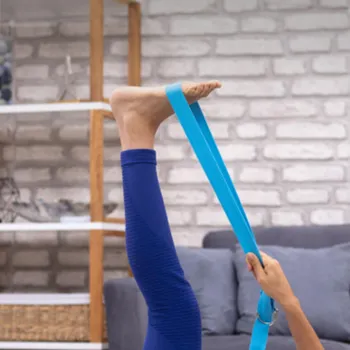Unleash the Power of Stretching for a Healthier You - Discover the Benefits of Flexibility & Wellness. Read on to know more
In the hustle-bustle of our daily lives, we often forget the simple things that
can significantly improve our overall well-being. Amongst these, stretching stands out as a practice that is easily overlooked.

But, did you know that incorporating regular stretching into your routine can unlock a world of benefits for your body? From improving flexibility to reducing stress, let's explore seven compelling reasons why you should make stretching a non-negotiable part of your day.
Stretching: essential for healthy, pain-free body
Imagine your body as a well-oiled machine. Over time, and with constant usage, parts can become stiff and less efficient. Stretching acts as the lubricant, easing the movement of your joints and muscles.
Think about it – after sitting for hours at your desk, don't you instinctively stretch your arms and legs? That's your body's way of telling you it needs release. Similarly, post-workout, stretching helps to reduce muscle soreness and improve recovery.
It prepares your body for action and aids in its repair afterwards. Stretching is not just for athletes or gym enthusiasts; it's for everyone! It's a simple yet powerful tool for maintaining a healthy and pain-free body.
So, let's delve into the amazing benefits of stretching, and discover how you can integrate it into your daily life. It is a valuable tool that contributes significantly to health.
Regular stretching improves flexibility for easier daily tasks
This is perhaps the most widely known benefit of stretching. Regular stretching helps to increase your range of motion, making everyday tasks easier to perform.
Bending down to pick up something, reaching for an item on a high shelf, or even simply turning your head to check your blind spot while driving – all become less strained and more comfortable with improved flexibility.
As we age, our muscles naturally tend to shorten and tighten, leading to stiffness and reduced mobility. Stretching counteracts this process, helping you maintain a more youthful and agile body.
Incorporate stretches that target major muscle groups like your hamstrings, quadriceps, back, and shoulders. Consistency is the key here. Even a few minutes of stretching each day can make a noticeable difference over time.
Remember, listen to your body and avoid pushing yourself too hard, especially when you're just starting out. Gentle and controlled movements are much more effective than forceful stretching.
Importance of stretching for correcting poor posture and preventing associated problems
In today's digital age, we spend a significant amount of time hunched over our smartphones, laptops, and tablets. This can lead to poor posture, which in turn can cause a host of problems such as back pain, neck pain, and headaches.
Stretching can play a crucial role in correcting these postural imbalances. Specific stretches can help to strengthen the muscles that support your spine and shoulders, allowing you to stand taller and maintain a more upright posture.
For example, chest stretches can help to open up the chest and shoulders, counteracting the rounding effect of prolonged sitting. Back extensions can strengthen the muscles in your lower back, providing better support for your spine.
Remember to focus on maintaining good form throughout your stretches to maximize their effectiveness and avoid injury. Practice mindfulness during your stretches, paying attention to your body and making adjustments as needed.
Stretching prevents muscle injuries; do dynamic warm-ups before, static after workouts
When your muscles are tight and inflexible, they are more prone to strain and injury. Stretching helps to loosen and lengthen your muscles, making them more resilient and less likely to get injured during physical activity.
Before any workout or sporting event, it's crucial to warm up your muscles with dynamic stretches. These are movements that mimic the activity you're about to perform, preparing your body for the demands ahead.
After exercise, static stretches, where you hold a stretch for a longer period, can help to cool down your muscles and reduce post-workout soreness.
Incorporating a regular stretching routine into your fitness regimen can significantly reduce your risk of injuries such as muscle strains, sprains, and even tendonitis. Remember, prevention is always better than cure, so make stretching a priority.
Stretching boosts blood flow for muscle health, vitality, and recovery
Stretching increases blood flow to your muscles and tissues, delivering vital nutrients and oxygen that are essential for their health and repair. Improved circulation can also help to flush out toxins and waste products, reducing inflammation and promoting faster recovery.
When you stretch, you are essentially opening up your blood vessels, allowing for better circulation throughout your body. This can lead to a number of benefits, including increased energy levels, reduced muscle fatigue, and improved overall health.
Simple stretches like arm circles, leg swings, and torso twists can be easily incorporated into your daily routine to boost your blood circulation. Consider stretching during breaks at work or while watching television to keep your blood flowing.
Stretching benefits mental health, reduces stress, improves mood
Stretching is not just beneficial for your physical health; it can also have a profound impact on your mental and emotional well-being. When you stretch, you release tension in your muscles, which can also alleviate mental stress.
Deep breathing exercises, often combined with stretching, can further promote relaxation and reduce anxiety. Stretching helps to calm the nervous system, slowing down your heart rate and lowering your blood pressure.
This can create a sense of peace and tranquility, helping you to better manage stress and improve your mood. Yoga and Pilates are excellent forms of exercise that combine stretching with mindfulness and breathing techniques, offering a holistic approach to stress relief.
Even a few minutes of stretching each day can make a noticeable difference in your stress levels.
Stretching enhances athlete performance, prevents injuries, and connects body and mind
For athletes, stretching is an essential component of training that can significantly enhance performance. Increased flexibility and range of motion allow for more efficient movement, improved power, and greater agility.
Stretching can also help to prevent injuries, allowing athletes to train harder and more consistently. Specific stretches can target the muscles used in particular sports, optimizing performance and reducing the risk of strain.
For example, runners can benefit from stretches that target their hamstrings, quadriceps, and calves, while swimmers can focus on stretches that improve their shoulder and back mobility.
Remember to consult with a coach or physical therapist to develop a stretching routine that is tailored to your specific sport and needs. It is important to understand that there is an inherent connection between the body and mind.
AI Generated Content. Glance/InMobi shall have no liability for the content











